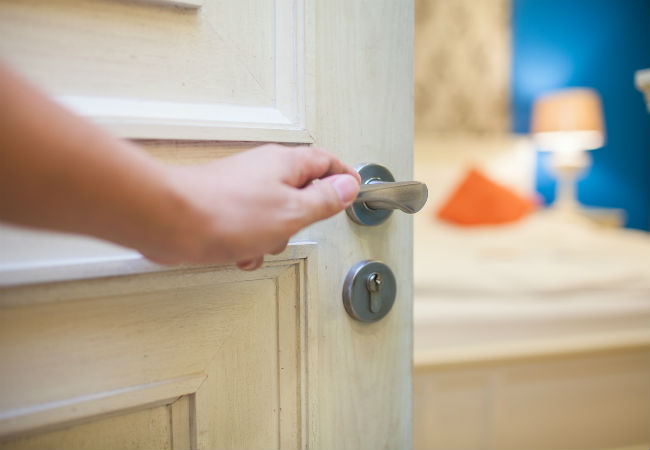We may earn revenue from the products available on this page and participate in affiliate programs. Learn More ›
Q: A door in my home tends to slam shut—even occasionally when no one is using it! What causes this and how can I prevent the door from slamming? I’m afraid the door might close on my cat’s tail or child’s fingers.
A: The sudden slam of a door is startling, but it quickly becomes annoying if it’s a frequent occurrence. Luckily, it’s generally a fairly simple problem to figure out and fix. The obvious reason for a slamming door is an inadvertently heavy-handed household member who exerts more force than necessary to close it. But when a gentle touch leads to a loud noise, or the door slams when no one’s near it, there’s probably one of two culprits afoot.
When a window in the room or elsewhere in the house is open, pressure changes could be to blame. As air moves from an area of higher pressure (inside your home) to an area of lower pressure (outside your home), the change can cause enough air movement to slam the door.
But a door opening or closing on it may indicate that it’s out of plumb—in other words, not perfectly vertical. Such unevenness can create a swing due to the door’s weight (especially if it’s a heavy, solid-core door) or an air current in the house.
If an overzealous family member is behind your open-and-shut case, remind him or her to handle the door gently. If not, consider the strategies below to get out of this slamming situation.
Slide in a doorstop.
If you like to keep the windows open but hate the slams of interior doors, simply wedge a doorstop underneath the offending door. It’s a low-tech, logical solution that you can play up, using a decorative doorstop that adds a little zing to the room.

Check the hinges.
Worn or improperly installed door hinges can lead to a slight imbalance, which in turn can lead a door to slam on its own. Open your door to a 90-degree angle and then set a level against the latch to see if the door is out of plumb. Tightening the hinge screws might correct the problem, but if the hinges themselves are worn, you’ll need to replace them.
You needn’t remove the door if you replace the hinges one at a time.
Start with the top hinge, unscrewing it from the door and then from the doorframe. Screw the new hinge onto the doorframe, using your level to check the alignment of the hinge until it’s completely vertical. Now screw the other side of the hinge to the door, again tightening until the hinge is plumb. Repeat the process on the middle and then the bottom hinges, each time checking the edge of the door for alignment. When everything is plumb, the door slamming should cease.

Try a few felt pads.
If slamming continues after adjusting the hinges, or the issue is caused by air pressure or cross breezes, try some of the self-stick felt pads normally used to keep décor from scratching furniture. Just stick a few small felt pads along the edge of the doorframe: Position a pad at the top and bottom of the frame, along with two more pads at the top and bottom of the strike plate. The pads provide just enough soft cushioning to slow down the door as it closes, preventing a slam.
Shush with weather stripping.
Felt pads might not do the trick on a heavier door, so try foam weather stripping to provide a soft, secure seal and muffle sounds. Wash away any dust or grime from the inside edge of the doorframe, cut a length of weather stripping (like this Frost King rubber foam tape, available on Amazon) to fit the full length of the doorframe, and then press it into place.
Put in a pneumatic closer.
If you find that your screen door slamming rattles you every time someone goes in or out, consider installing a pneumatic door closer to take on the task of closing the door. These air-powered devices attach between the doorframe and the door edge and use an air-filled piston to slowly swing the door closed. Most are adjustable, so you can slow the door’s swing down enough to prevent a slam.

